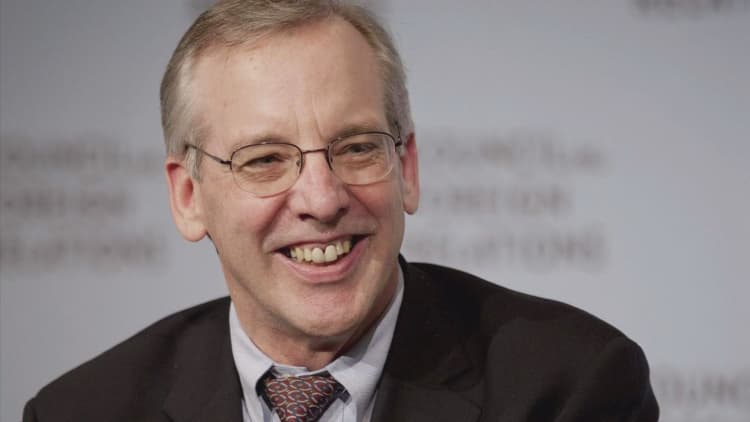
All year long, the market has been sending a message that the Fed until recently refused to heed — namely that the central bank's desire to raise interest rates on a regular basis isn't going to happen.
Now, "lower for longer" is working its way into replacing all of the various wordplay incrementalism that has marked Fed policy statements and speeches. Markets have been obsessing over a central bank that has time and again been unable to deliver on its promises — or threats, depending on your perspective — to normalize interest rates after eight years of highly accommodative policy.
But the idea that the Fed is stuck in the low-rate regime for longer than virtually anyone imagined is slowly taking root, and is the subject of much discussion and analysis on Wall Street.
"Are super-low interest rates here to stay? There is a growing consensus that they are," Josh Feinman, chief global economist at Deutsche Asset Management, wrote in a report for clients.
"This is one reason policymakers have been slow to raise rates; they're not only wary of heightened global stresses, lingering slack, below-target inflation, and asymmetric risks near the zero bound, and hold out hope that supporting demand can help repair at least some of the damage to potential output ... they also increasingly judge that the neutral rate will remain lower for longer," he added.
Feinman starts with the premise that the "neutral rate," or the short-term rate needed to keep the economy growing and inflation stable, is lower than most experts believed. The view has been espoused by leading thinkers like economist Larry Summers and, more recently, bond king Bill Gross and former Fed Chairman Ben Bernanke, who explored the issue in a recent blog post.
A low neutral rate means the Fed can keep its own funds rate low, which translates to muted rates across the board.
"The economy's unusual performance in recent years — abnormally low interest rates, slower-than-anticipated growth yet greater-than-expected declines in labor market slack juxtaposed against persistently below-target inflation — has left many (both inside and outside the Fed) scratching their heads, less certain of many things, including the neutral rate, potential growth, and slack," Feinman wrote.
What the Fed does, of course, has major implications. The central bank lowered its target rate to near-zero in late 2008 and kept it there for seven years before hiking a quarter-point in December 2015, a period during which it injected $3.7 trillion of liquidity into the financial system. All told, the Fed's efforts have coincided with a 225 percent increase in the stock market index.
While some may like low rates, abnormally low ones aren't a particularly good sign. In the current climate, they indicate weak growth both in the U.S. and abroad as the Fed finds itself constrained from hiking as its peers hold rates in low and sometimes negative territory.
But at least from the market's perspective, investors can dial down the ongoing obsession with every Fed proclamation and post-meeting language twist. Any thought that the central bank would embark on the rate-hiking cycle indicated in December, when it raised for the first time in more than nine years, is fading away.
St. Louis Fed President Jim Bullard, in a recent analysis of economic "regimes," indicated as much, and the Fed backed that up at the July meeting when it gave little indication it was ready to hike anytime soon. New York Fed President Bill Dudley gave a mild warning Tuesday of a possible September hike, but it only caused a tepid ripple in the market. (In his blog post, Bernanke advised investors to dismiss most Fed speak and focus instead on data.)
"I believe it is going to be lower for longer, and I thought that for the last year and a half," said Michael Yoshikami, founder and CEO of Destination Wealth Management. "All this hand-wringing about what adjectives the Fed is using on a quarterly basis is not only nonproductive, but I don't think it's accurate."
Traders in the specialized fed funds futures market, at least, never really believed the Fed's so-called dot plot, which back in December indicated four rate hikes were in store for 2016. Those traders never priced in more than two moves this year, and for a while weren't even figuring on one. Most recently, the futures market was estimating a 55 percent chance of a move in December.
But that's becoming beside the point. Once the market accepts "lower for longer," it can move on from playing a guessing game eight times a year (the number of Federal Open Market Committee meetings) and focus on valuation issues besides interest rates, which likely aren't going very far in the coming years.
"How many times does the Federal Reserve have to say they're concerned about inflation and take it back a month later until people realize that the words are not necessarily going to lead to action?" Yoshikami said. "This has been a Federal Reserve head-fake for years."
Count him as a skeptic that investors can break their Fed obsession.
"It should, and I think it incrementally might start to happen," he said. "There's a culture of Fed watch that people are fixated on that's going to be a very hard addiction to break."
Jim Paulsen, chief investment strategist at Wells Capital Management, also sees the market having a hard time from moving on, though he sees at least one encouraging sign.
"You've always had people who accepted the lower-for-longer argument," he said. "The biggest thing that's happened in the last 90 days is the Fed has accepted it."


